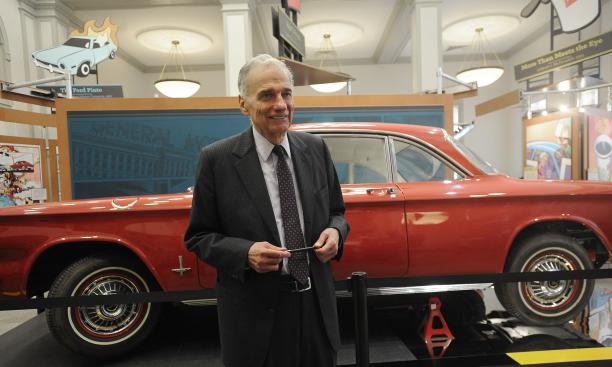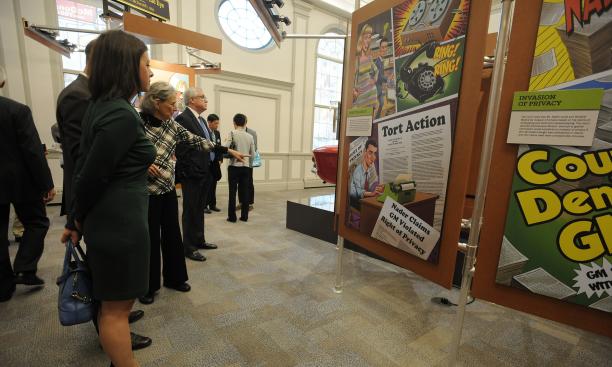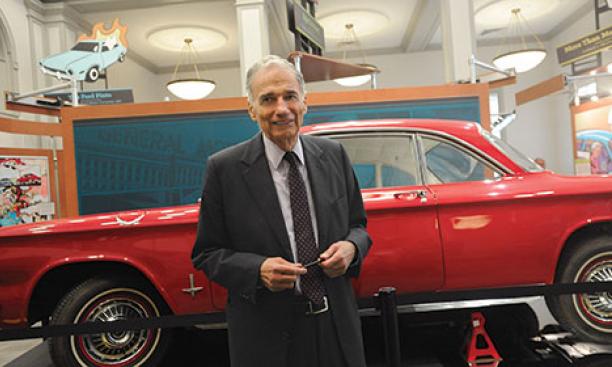There are more than 35,000 museums in the United States dedicated to subjects as varied as barbed wire, bananas, and hammers. But there was no museum exclusively about the American legal system’s tort law until Ralph Nader ’55 opened one.
The American Museum of Tort Law — located in a 6,500-square-foot former bank in Nader’s hometown of Winsted, Conn. — threw open its doors Sept. 26 to several hundred people with a ceremony featuring lawyers, professors, and rocker Patti Smith, a longtime Nader supporter, who sang “People Have the Power.” The museum has been a passion project for the 81-year-old consumer advocate, who spent more than 17 years raising nearly $3 million for the project.
The law of torts — the term for a legal wrong that can become the basis for a civil lawsuit — does not easily lend itself to museum treatment. But Nader believes that tort law is inherently interesting because it is so closely tied to daily experience: Everyone has ridden in a car, played with a toy, or drunk a hot beverage. By learning how people have sought redress for wrongful injuries, he says, “you can carry these ideas of civil justice out the door” and become a more engaged citizen.
The most prominent display is the symbol of Nader’s most famous crusade: a 1963 Chevy Corvair, the car with dangerous design defects that became the focus of Nader’s 1965 book Unsafe at Any Speed. The rear of the car is jacked up above a mirror so visitors can see its faulty suspension.
There is a lathe similar to the one involved in a landmark 1963 case establishing the rule of strict liability for defective products and a Fisher-Price toy school bus with removable figures that later were found to be choking hazards.
A large display explains Liebeck v. McDonald’s Restaurants, the 1994 New Mexico case in which a jury awarded the plaintiff $2.86 million after she was scalded by hot coffee. Colorful, cartoonlike drawings explain other landmark cases. The gift shop sells refrigerator magnets depicting the Ford Pinto bursting into flames and a 1,200-page torts casebook. Eventually, says executive director Richard Newman, the museum plans to add a mock courtroom where visitors can watch re-enactments of famous tort cases.
The museum’s motto is “The Law Works,” which may be the most succinct summation of the personal creed of a man known as a modern Jeremiah railing against the depredations of greedy corporations. Wearing his trademark dark suit and tie, Nader said people don’t know enough about the civil-justice system and don’t appreciate their role in it and their responsibility for maintaining it. He scorned those who try to get out of jury duty, for example, calling service “an honor.”
A court of law, Nader said, is the closest we come to direct democracy — a case decided by a jury of one’s peers, open to the press, with an appealable verdict and a public record. As Nader repeatedly told his audience at the dedication, the poorest citizen can go to court and force the mightiest corporation to account for its actions.
There are more than 35,000 museums in the United States dedicated to subjects as varied as barbed wire, bananas, and hammers. But there was no museum exclusively about the American legal system’s tort law until Ralph Nader ’55 opened one.
The American Museum of Tort Law — located in a 6,500-square-foot former bank in Nader’s hometown of Winsted, Conn. — threw open its doors Sept. 26 to several hundred people with a ceremony featuring lawyers, professors, and rocker Patti Smith, a longtime Nader supporter, who sang “People Have the Power.” The museum has been a passion project for the 81-year-old consumer advocate, who spent more than 17 years raising nearly $3 million for the project.
The law of torts — the term for a legal wrong that can become the basis for a civil lawsuit — does not easily lend itself to museum treatment. But Nader believes that tort law is inherently interesting because it is so closely tied to daily experience: Everyone has ridden in a car, played with a toy, or drunk a hot beverage. By learning how people have sought redress for wrongful injuries, he says, “you can carry these ideas of civil justice out the door” and become a more engaged citizen.
The most prominent display is the symbol of Nader’s most famous crusade: a 1963 Chevy Corvair, the car with dangerous design defects that became the focus of Nader’s 1965 book Unsafe at Any Speed. The rear of the car is jacked up above a mirror so visitors can see its faulty suspension.
There is a lathe similar to the one involved in a landmark 1963 case establishing the rule of strict liability for defective products and a Fisher-Price toy school bus with removable figures that later were found to be choking hazards.
A large display explains Liebeck v. McDonald’s Restaurants, the 1994 New Mexico case in which a jury awarded the plaintiff $2.86 million after she was scalded by hot coffee. Colorful, cartoonlike drawings explain other landmark cases. The gift shop sells refrigerator magnets depicting the Ford Pinto bursting into flames and a 1,200-page torts casebook. Eventually, says executive director Richard Newman, the museum plans to add a mock courtroom where visitors can watch re-enactments of famous tort cases.
The museum’s motto is “The Law Works,” which may be the most succinct summation of the personal creed of a man known as a modern Jeremiah railing against the depredations of greedy corporations. Wearing his trademark dark suit and tie, Nader said people don’t know enough about the civil-justice system and don’t appreciate their role in it and their responsibility for maintaining it. He scorned those who try to get out of jury duty, for example, calling service “an honor.”
A court of law, Nader said, is the closest we come to direct democracy — a case decided by a jury of one’s peers, open to the press, with an appealable verdict and a public record. As Nader repeatedly told his audience at the dedication, the poorest citizen can go to court and force the mightiest corporation to account for its actions.








